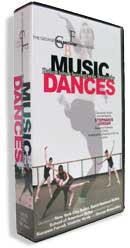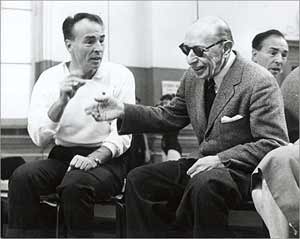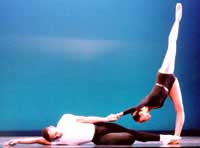
The history of ballet is populated by works whose choreographies were neither notated nor filmed. For this reason, sophisticated analyses of the dialogue between music and dance in ballet are few and far between. Stephanie Jordan, the pre-eminent scholar in this nettlesome field, has demonstrated an impressive ability to tease out the relationships between sight and sound in (primarily) 20th-century ballets. The works in question may be amorphous and ephemeral, but Jordan’s analyses are as accurate and precise as architectural blueprints. In a recent lecture bearing the subtitle “Ghost Stories,” Jordan traced the lengthy genesis of the “Divertimento” from Le Baiser de la Fée, a ballet featuring choreography by George Balanchine and music by Igor Stravinsky. The lecture, a nimble academic primer involving live performance, probed one of the central questions in modernist aesthetics: the relationship in dance and music between “narration” and “abstraction.”
Music Dances, an educational video addressing the entire history of the Balanchine-Stravinsky relationship, offers a concise study of the ways in which rhythmic and physical gestures interact and intersect in seven ballets. Some of these are shown as performed on stage (by the New York City Ballet, the Dutch National Ballet, and the School of American Ballet), others as rehearsed in studio. Products of a self-conscious media age, the three Greek-themed ballets for which the Balanchine-Stravinsky partnership is best known—Apollo (1928), Orpheus (1948), and Agon (1957)—occupy special places in the hearts of balletomanes, as do the twenty-six (!) other ballets that Balanchine based on new and pre-existing Stravinsky scores. Throughout the video, which Jordan narrates, she intimates that Balanchine was less concerned with preserving fixed versions of his works than Stravinsky. His choreographies lived and evolved, his décors were simplified, and his female dancers slimmed down. Jordan also intimates, however, that Balanchine had a profound influence on Stravinsky. The two artists stoked each other’s creative furnaces, leading to the invention of music that sounded like dance and, conversely, dance that looked like music.

How did this synaesthesic exchange occur? Jordan, who maintains a reserved, thoughtful presence on camera, begins her pedagogical exposé with several examples of how Balanchine’s choreography “visualizes” Stravinsky’s music. These include runs sur la pointe above pizzicato strings, even- and odd-numbered entrechats to even- and odd-numbered beat patterns, body contractions on low chords, and so forth. Jordan suggests that Balanchine’s choreography more often responds to aspects of meter and pitch than to dynamic and texture. Jennifer Tinsley, Peter Boal, and Kathleen Tracey prove the point with studio demonstrations accompanied by the pianist Nancy McDill and violist Gabriel Schaff. (Tinsley, to my mind, steals the show, moving with streamlined grace through Balanchine’s patterns.) Jordan next explains the rudiments of twelve-tone composition, though not serialism, as well as the aesthetic premises of (Stravinskian) neoclassicism. Though the point is not made explicit, the viewer learns that Balanchine’s visualizations of twelve-tone collections tend to assume geometric shapes, with some pitches maintaining pride of place over others. In the choreography for Movements for Piano and Orchestra (1963), for example, Balanchine assigns the corps de balletpitches 1-5 and 8-12 of the governing collection, and the female soloist pitches 6-7 [View excerpt from Movements]. Once struck, the twelve pitches fade away, but the dancers hold form at the sides and the center of the visual frame. The music stays in the eye rather than the ear.
Henceforth, the discussion becomes much more complex, with Jordan using charts and diagrams to demonstrate the differences, rather than the similarities, between Balanchine’s and Stravinsky’s approaches to meter and rhythm. Visual sequences, she makes clear, can have one more or one less beat than musical sequences, accents can be inserted and deleted, and transitions can be pared away. Jordan reveals that while Balanchine’s choreographies tend to begin with Stravinsky’s music, sooner or later they “leave the music behind” and “find their own form.” The supreme example of dance-music interaction comes in Balanchine’s 1972 choreography of Stravinsky’s 1931 Violin Concerto, a ballet that elevates the concept of audio-visual counterpoint to an eye- and ear-taxing level of intensity. Jordan charts the motion of groups of dancers in and out of sync with the music, in and out of sync with each other, and finally in and out of sync with the music and each other at the same time. Visual canons are tucked inside musical canons. Concluding her analysis, Jordan notes that the Violin Concerto was “as far as Balanchine ever went” in the direction of “multi-system” choreography. The artist perhaps realized that phrases, whether visual or musical, tend to lose definition when expanded and contracted too often.
Towards the end of Music Dances, Jordan moves beyond pedagogy to address broader conceptual concerns. She points out, for example, that in choreographing Le Baiser de la Fée Balanchine eliminated transition sections from the music, thus transforming a relatively early Stravinsky score (1928) into a late Stravinsky score. (The cuts were made after the composer’s death.) The bulk of the discussion centers not on this ballet, however, but on Agon, with special attention paid to the “Bransle Gay” for solo female dancer and the concluding “Pas de deux.” The original and revised versions of the first of these numbers [View “Bransle Gay” excerpt] bears witness to the invention of a capricious echappé in second position followed by a plié sur la pointe. This striking physical gesture is accompanied by an equally striking musical gesture—an eleventh-chord in the low register, sounded by the hitherto unheard harp and strings—but the former is seen before the latter is heard. Balanchine’s choreographic novelty, in short, is misaligned with Stravinsky’s musical one. At this juncture, Jordan clarifies how the dialogue (or, more precisely, the Olympic “contest”) between dance and music in the “Bransle Gay” has evolved over time. In some performances of the work, one finds the music outshining the dance; in others, the opposite seems to be the case. Jordan’s comparison of the 1957 and 1960 versions of the “Bransle Gay,” with the video version made in 2001 witnesses an increase in technical precision on the part of the solo performer and a tightening, rather than a loosening, of formal constraints. Though the internal elements of this hypnotic work can be shuffled around, the external structure proves unassailable.

The “Pas de deux” from Agon constitutes a fitting conclusion to the video, marking, as it does, a famously sensual and seamless integration of sight and sound. Wendy Whelan, who performs with Albert Evans on Music Dances, points out in her interview with Jordan that physical gestures are literally “pulled out” of acoustic gestures. In doing so, she implies that the choreography is somehow an extension of the music and, more profoundly, that space is somehow an extension of time. Suzanne Farrell, also interviewed on the video, adds that the “Pas de deux” has “nothing to do with a man or a woman, but everything to do with the quality of the movement.” Terpischore, the Muse of Dance, would blanche at the eroticism of some performances of the work. What Whelan and Evans offer on the video, however, is a jewel of restraint.
Music Dances is both a superb educational primer and an engaging theoretical treatise, one that touches on the ontological frailty of ballet both as a performed and recorded medium. Jordan assesses the dance-music dialogue in discrete sections of Balanchine and Stravinsky’s ballets; in doing so, she takes them out of context. The outcome of her analyses, which involve seeing and hearing examples two or three times in succession, is a sectional reading of sectional works, a visualization of visualization. The repetitions are essential for following the argument; indeed, at times one wishes that Jordan lingered longer over her examples to consider not only the ways in which music and dance fundamentally interact, but also the ways in which they fundamentally diverge. Though music and dance move in and around each other, they inhabit different expressive realms, different expressive worlds, and this difference merits bearing in mind when comparing and contrasting meters and phrase lengths. In narrative and non-narrative ballets alike, the distinction between the two media can be as concrete, or as illusory, as that between the conscious and the unconsciousness, the natural and the supernatural, signification and symbolization.
Time—both actual and oneiric—is the essence of ballet, and time is the essence of this video. Just as pendulums marked an advance over verges and foliots in traditional clock-making, Balanchine and Stravinsky’s audio-visual counterpoint marked an advance over the lockstep motion and four-square phrasing typical of older (narrative) ballet. The subtlety of this dialogue becomes manifest in the insert about Apollo, where Jordan reports that Calliope, the Muse of Poetry, manages to “show” Stravinsky’s “notes” but also the “rests” in between them.
Simon Morrison
Princeton University
Works Cited
Jordan, Stephanie.“Divertimento from Le Baiser de la Fée: Ghost Stories.” From the Mariinsky to Manhattan: George Balanchine and the Transformation of American Dance Symposium. University of Michigan, Ann Arbor. 31 Oct. 2003.
